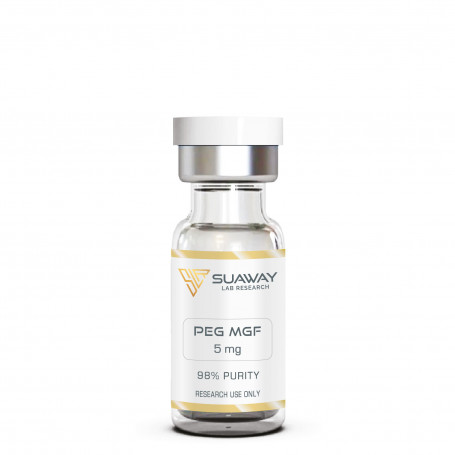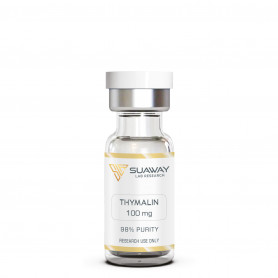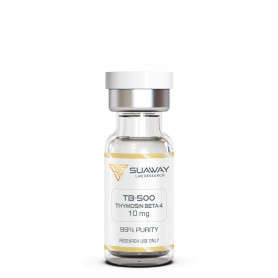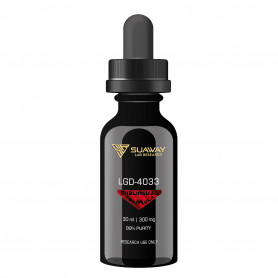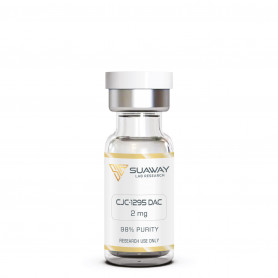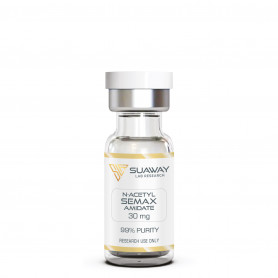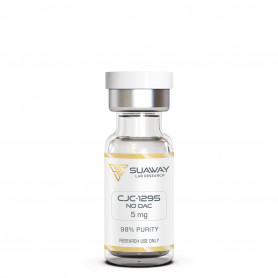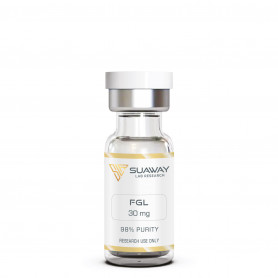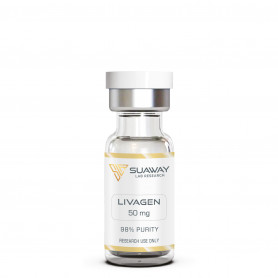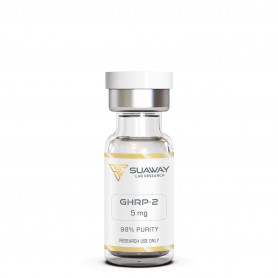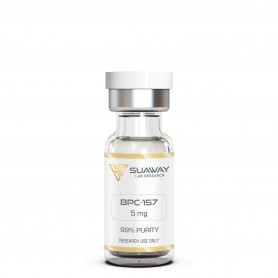PEG MGF - 5mg
Pegylated Mechano Growth Factor (PEG MGF) is a subtype of IGF-1 (insulin-like growth factor-1), which promotes the division of myoblasts and permits the fusion and maturation of muscle fibers.
The following therapeutic benefits of PEG-MGF have been shown through research:
- Ability to re-build muscles
- Ability to make new muscle cells
- Neuroprotective effects
- Cardioprotective effects
- Promotes wound healing and tissue regeneration
- Promotes bone injury recovery
- Lowers total body fat and cholesterol
- Increases immunity
Description
STRUCTURE
Sequence: PEG-Suc-Tyr-Gln-Pro-Pro-Ser-Thr-Asn-Lys-Asn-Thr-Lys-Ser-Gln-Arg-Arg-Lys-Gly-Ser-Thr-Phe-Glu-Glu-Arg-Lys-Cys
Molecular Formula: C121H200N42O39
Molecular Weight: 2888.16 g/mol
CAS: 108174-48-7
Peptide purity: Greater than 98%
Other details: No TFA Salt
Storage: Lyophilized peptide must be stored at -20°C and peptide solution at 4°C.
PEG-MGF has low oral and excellent subcutaneous bioavailability.
DESCRITPION
Insulin-like growth factor 1 (IGF-1) has been shortened and significantly changed to become a pegylated mechano-growth factor (PEG-MGF). It promotes myoblast (muscle cell) development and proliferation, according to research.
PEG MGF, a splice variant of the IGF gene, is used to promote the growth and development of tissue, particularly muscle. It enables the muscle fiber to fuse and mature by increasing the number of stem cells in the body. This procedure is essential for mature muscular development. The difference between IGF-1 and MGF is that the latter promotes myoblast division by activating several receptors.
MGF's initial use was limited since the medicine quickly broke down within the body. Since then, pegylation has been discovered as a useful method of stopping the breakdown (the process in which MGF molecules were agglomerated to molecules of polyethylene glycol). Due to the formation of a protective layer, the MGF was able to travel through the bloodstream without breaking down or losing its bioactivity or ability to grow muscle.
The process of pegylation involves joining polyethylene glycol with another chemical substance. It is often done to lessen the body's natural immunological response to an agent or, as in the instance of PEG-MGF, to lengthen the compound's half-life in the blood by slowing renal clearance. PEG-MGF was created because, as was already explained, MGF has a relatively short half-life in the blood. PEG-MGF aids in overcoming this specific drawback.
It lowers cholesterol and overall body fat, according to research. Additionally, there is some evidence to support the idea that PEG-MGF enhances immune activity associated to wound healing, which could speed up the healing process.
Direct injection of MGF into muscle may protect cells by lowering inflammatory hormone expression and oxidative stress, according to research in a mouse model of muscle damage.
Another study demonstrates that MGF controls muscle inflammation and enhances the migration of neutrophils and macrophages to the site of damage. The fact that exercise-induced muscle injury increases the production of IGF-1Ea and IGF-1Eb, both of which are closely connected to MGF, is the basis for these investigations.
International endocrinology experts' studies have shown that MGF activates the insulin-like growth factor 1 receptor like that of IGF-1. In humans, stimulation of this receptor has been associated with reduced aging, elevated lean body mass, and enhanced energy balance. According to this function, PEG-MGF may have effects like those of IGF-1, resulting in better muscle regeneration, increased fat metabolism, or overall improvements in lean body mass.
Additionally, research in mice shows that giving MGF to exercising mice results in a 25% increase in mean muscle fiber size. The authors Goldspink and Jakeman point out that the MGF was injected directly into the muscle in this research, which is a severe constraint since the protein would need to be injected into every muscle where hypertrophy is to be maximized. This specific issue is resolved by PEG-MGF, which lengthens MGF's plasma half-life and makes it possible to deliver it with a single intramuscular injection rather than numerous ones.
Research from the University of Illinois' bioengineering department demonstrates that MGF prevents the heart muscle cells' programmable cell death as a result of hypoxia. The peptide also seems to draw cardiac stem cells to the site of damage, which might aid in heart attack recovery and regeneration. In comparison to controls that did not receive MGF, rats in the research that received MGF within eight hours of hypoxia had decreased cell death and increased stem cell recruitment.
Similar studies suggest that by lowering pathologic hypertrophy, targeted administration of MGF might enhance cardiac function after a heart attack. Similar findings from other research indicate that MGF injections after an acute myocardial infarction may lessen cardiomyocyte damage by up to 35%.
According to rabbit research, PEG-MGF may speed up bone regeneration by encouraging osteoblasts, the cells that mineralize bone, to multiply. Rabbits given large dosages of MGF healed to the same extent after four weeks as was seen at six weeks in controls. According to other research, MGF promotes the movement of chondrocytes from the bone where they grow into the cartilage where they have an impact.
A study on the long-term impact of elevated MGF levels in the brain and central nervous system was recently evaluated by Alexander Walker, Editorial Assistant at BioMed Central. According to the research, mice who have greater levels of MGF have fewer signs of age-related neuron degeneration and continue to function at their highest level cognitively far into the old life.
In mice models of ALS, MGF therapy has also been demonstrated to lessen motor neuron loss and improve muscular weakness. It seems that MGF is overexpressed in areas of the brain where neuron regeneration is highest after hypoxia damage and is naturally expressed in the brain after hypoxic injury. Exogenous MGF might potentially lessen the effects of a variety of neurological conditions without treating the underlying cause because it stops neurons from dying in the brain and spinal cord even when the illness process is still active.
REFERENCES
X. Liu et al., "Impaired Skeletal Muscle Regeneration Induced by Macrophage Depletion Could Be Partly Ameliorated by MGF Injection" [PMC]
Keng-Ting Sun et al., "Overexpression of Mechano-Growth Factor Modulates Inflammatory Cytokine Expression and Macrophage Resolution in Skeletal Muscle Injury" [PMC]
A. Philippou et al., "Expression of IGF-1 isoforms after exercise-induced muscle damage in humans: characterization of the MGF E peptide actions in vitro" [PubMed]
J.L. Janssen et al., "Potency of Full-Length MGF to Induce Maximal Activation of the IGF-I R Is Similar to Recombinant Human IGF-I at High Equimolar Concentrations" [PubMed]
G. Goldspink et al., "Research on mechano growth factor: its potential for optimising physical training as well as misuse in doping" [British Journal of Sports Medicine]
G. Doroudian et al., "Sustained delivery of MGF peptide from microrods attracts stem cells and reduces apoptosis of myocytes" [PubMed]
J.R. Pena et al., "Localized delivery of mechano-growth factor E-domain peptide via polymeric microstructures improves cardiac function following myocardial infarction" [PubMed]
M. Deng et al., "Mechano growth factor E peptide promotes osteoblasts proliferation and bone-defect healing in rabbits" [PubMed]
X. Jing et al., "Mechano-growth factor protects against mechanical overload induced damage and promotes migration of growth plate chondrocytes through RhoA/YAP pathway" [PubMed]
Jing-Tao Chen et al., "Mechano-growth factor regulated cyclic stretch-induced osteogenic differentiation and MMP-1, MMP-2 expression in human periodontal ligament cells by activating the MEK/ERK1/2 pathway" [PubMed]
A. Walker et al., "Hearts and Minds of Mice and Men: Mechano Growth Factor a new tool in the battle against age-related neuron loss?" [BMC]
J. Dluzniewska et al., "A strong neuroprotective effect of the autonomous C-terminal peptide of IGF-1 Ec (MGF) in brain ischemia" [PubMed]
DISCLAIMER
This product is intendend for lab research and development use only. These studies are performed outside of the body. This product is not medicines or drugs and has not been approved by the FDA or EMA to prevent, treat or cure any medical condition, ailment or disease. Bodily introduction of any kind into humans or animals is strictly forbidden by law. This product should only be handled by licensed, qualified professionals.
All product information provided on this website is for informational and educational purposes only.

